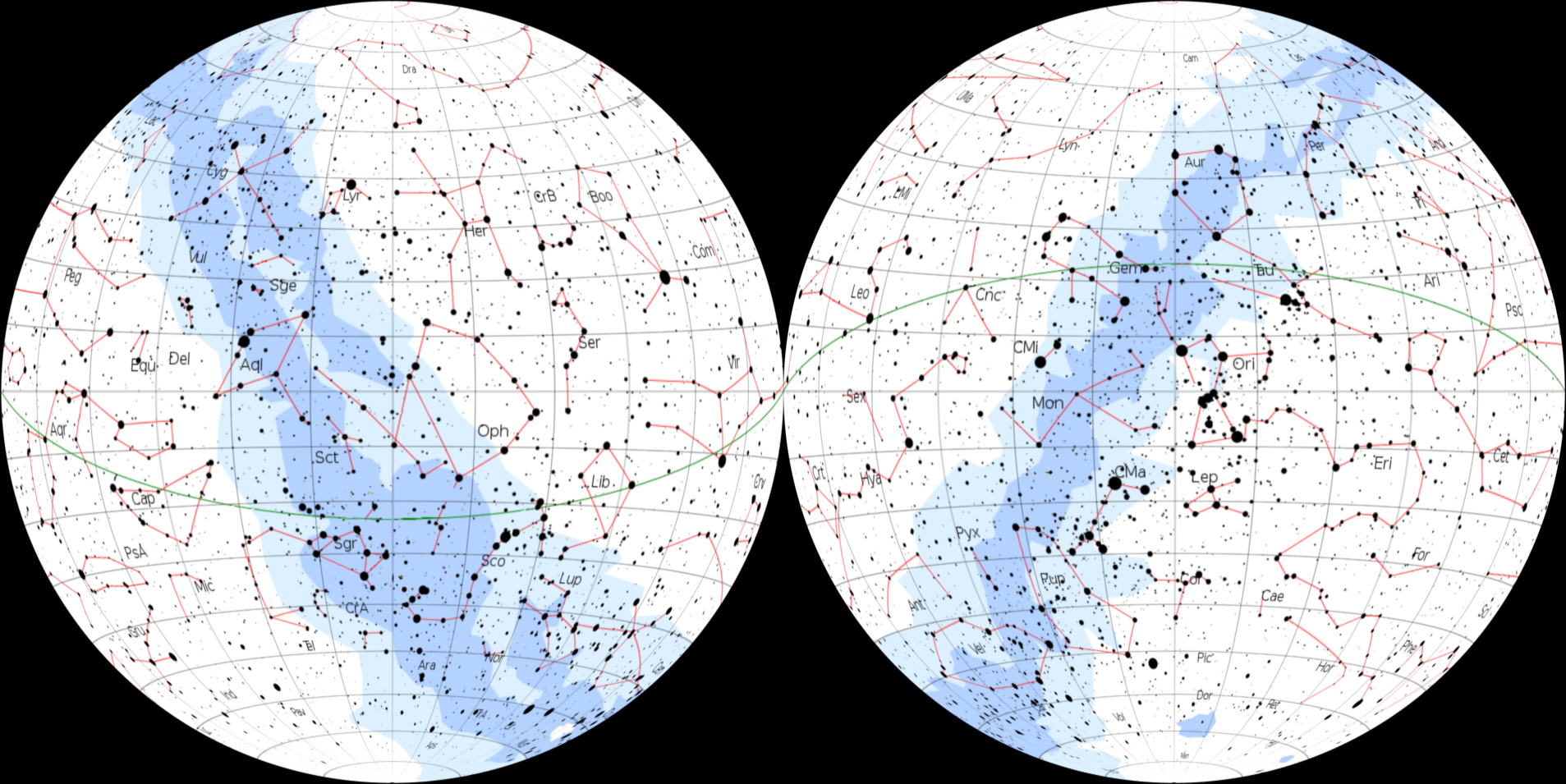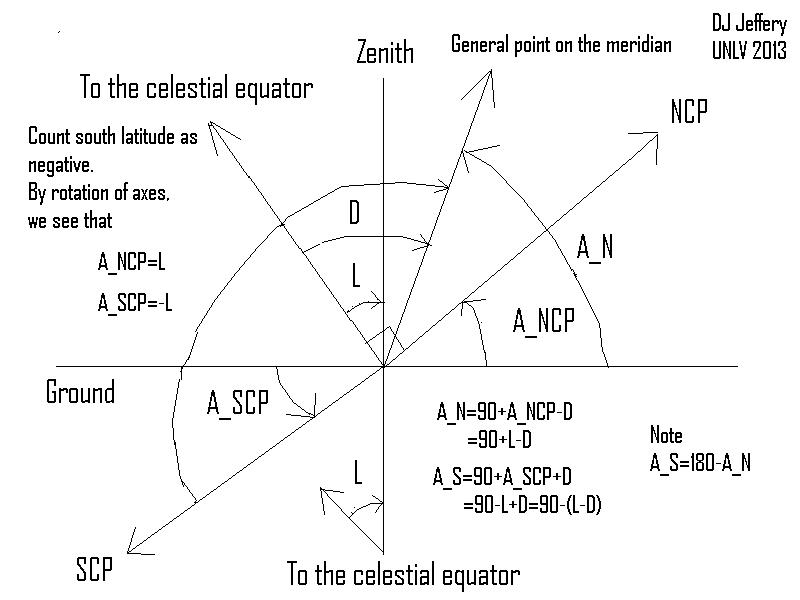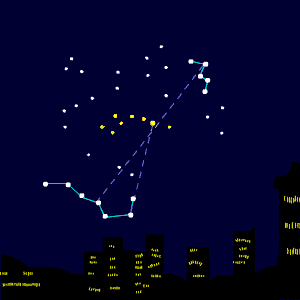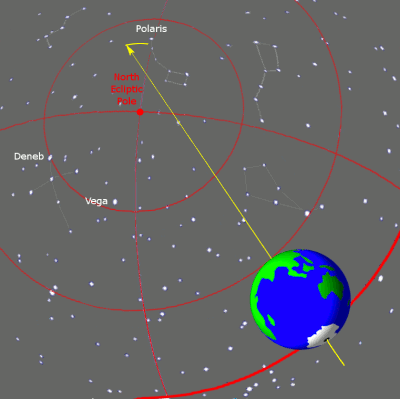But because the
horizon cuts the
celestial sphere in half,
some astro-body
small circle paths
are cut in half---and some are not.
What decides?
First, to be simple, let's just consider a
Northern Hemisphere case:
the Southern Hemisphere
is sort of the mirror image case.
Next note that
NCP is
one thing on the sky with a fixed
altitude
with respect to time (but not location on Earth)
since it does NOT rotate with the
celestial sphere.
A little geometry shows that
NCP's
altitude
is equal to the latitude
of the observation location.
If a
small circle is
too nearer the
NCP than
the NCP's
altitude,
then
small circle never
falls below the horizon
and its astro-body
is always above the horizon.
If a
small circle is
too nearer the
SCP than
an angle equal to
the NCP's
altitude,
then
small circle never
rises above the horizon
and its astro-body
is always below the horizon.
Astro-bodies
that never rise or set are called circumpolar objects:
they could be
circumpolar stars
circumpolar constellations.
So any astro-body
closer to the
NCP than
an angle equal to the local
latitude
is circumpolar and never sets.
And any astro-body
closer to the
SCP than
an angle equal to the local
latitude
is circumpolar and never rises.
All other astro-bodes
are NOT circumpolar and rise and set every day on the
horizon.
These non-circumpolar
astro-bodes follow
arcs on the sky which are the visible
part of their
small circle paths.
Extra-solar-system astro-bodes
always rise and set at the same
azimuths
(which are equal in magnitude and opposite in sign)
at least approximately over the course of a human lifetime.
Solar-system astro-bodes
move continuously on the
celestial sphere
and this is noticeable over very short time periods.
How does the Sun move on the sky.
Well everyday it circles west on a
small circle.
So it follows an arc on the sky when
above the horizon.
But it also moves relative the
celestial sphere
thought of as attached to the
fixed stars on eastward
the ecliptic.
It takes one year (approximately 365.25 days) to complete it's
path on the ecliptic.
So it moves at about 1 degree per day---the ancient Babylonians
may have chosen to divide the circle into 360 degrees to get this angular velocity.
This means the small circle
path of the Sun
varies north and south of the celestial equator
by the Earth's axial tilt of 23.4 degrees.
The maximum declination
is called the summer solstice.
Minimum is called the winter solstice.
When the Sun is on the
celestial equator, it
is called an equinox:
when the Sun is going north
it is the vernal equinox
and when it is going south is the
fall equinox.
The solstices
and equinox happen
about 91 days apart.
Fiducial dates are Mar21 vernal equinox,
Jun21 summer solstice,
Sep21 fall equinox,
and
Dec21 winter solstice.
The actual dates of the
solstices and equinoxes
vary a bit for several reasons.
The main one is that the solar year
(vernal equinox to
vernal equinox) is NOT
a whole number of days: it is about 365.242 days---it varies a bit due all kinds of things.
But calendar years
have whole numbers of days.
We fixed things up to keep
solar year count and
calendar year count synchronized over long periods of time by
alternating the length of the calendar year between
365 days (ordinary years) or 366 days (leap years)
in a way prescribed by the
Gregorian calendar.
Because of the short-term desynchronization of the
solar year count and
calendar year count
the solstices and equinoxes
can move a calendar day or so off the fiducial dates.
The Solstices and equinoxes
mark the beginnings of the astronomical
seasons that their names indicate.
Because the Sun moves continuously eastward
relative to the
fixed stars, one can
also say that the fixed stars
move continuously westward relative to the
Sun
This means that the
solar times
for fixed stars
happen earlier every day: rises times, setting times, and
transit times.
For example, say a particular star
transits the
meridian at the same time
as the Sun (i.e., at
solar noon) on a given day.
This means the star and
Sun are at the same
RA.
Next day, the
star has moved westward
from the Sun and will
transit the meridian
before solar noon.
Of course, earlier and earlier times eventually cycle back to the times where they started.
If a star rises with the
Sun on a given
day (called its
heliacal rising), then
it will rise earlier and earlier until a year later is it is rising with the
Sun again.
As the Sun moves eastward
on the ecliptic
it passes though various
constellations.
Which constellations
the Sun
and ecliptic passes
through depends on how you define
constellation
and how you define passing through a
constellation.
But in traditional astrology,
their are 12 constellations
on the ecliptic
which are called the
zodiac constellations:
Aries,
Taurus, etc.
On average, it takes about 30 days for the
Sun to move through a
zodiac constellation.
You cannot observe the
zodiac constellation
the Sun is in, except
you can see part of it at
sunrise and sunset.














